Creative art projects can help ease your anxious mind by fostering self-expression and mindfulness. Try coloring intricate designs or nature-themed books to promote relaxation and focus. Mandala art can also be a calming practice, encouraging you to immerse yourself in shapes and colors. Feel free to get playful with DIY supplies, crafting your own unique materials for a personal touch. Listening to music while you create can elevate your experience, syncing your emotional state with your art. These activities not only relieve anxiety but also ignite your creativity, leading to more exploration in the colorful world of art.
Benefits of Art Therapy
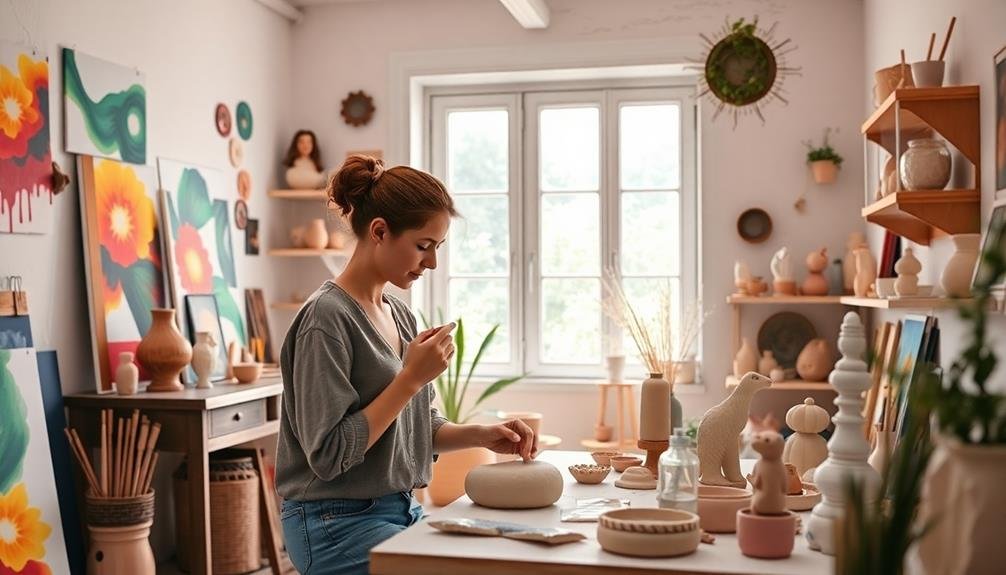
Engaging in art therapy offers numerous benefits that can enhance your emotional well-being. When you immerse yourself in creative activities, you tap into a powerful form of self-expression. This not only helps you articulate feelings you might struggle to put into words but also promotes a sense of relief as you externalize your thoughts and emotions.
Art therapy can reduce stress and anxiety, allowing you to focus on the present moment. As you create, your mind becomes absorbed in the process, helping you to shift your focus away from daily worries. This meditative aspect of art can foster relaxation, leaving you feeling more centered and calm.
Furthermore, engaging in artistic activities can boost your self-esteem. Each completed project serves as a tangible representation of your capabilities, which can empower you and instill a sense of accomplishment.
Moreover, experimenting with colors and techniques can spark joy and encourage playful exploration, rekindling your inner child.
Choosing the Right Coloring Book
Finding the right coloring book can enhance your creative experience and amplify the benefits of art therapy. Start by considering your interests; whether you enjoy intricate designs, whimsical illustrations, or nature themes, select a book that resonates with you. This personal connection will make the activity more enjoyable and fulfilling.
Next, think about the complexity of the designs. If you're new to coloring or feeling particularly anxious, you might want to choose simpler patterns that require less concentration. As you become more comfortable, you can gradually move on to more challenging pages.
Don't forget to check the paper quality, too; thicker paper can handle various mediums like colored pencils, gel pens, or markers without bleeding through.
Also, consider the size of the book. A larger format can give you more space to express your creativity, while a smaller book is portable and easy to take on the go.
Mandala Designs for Mindfulness
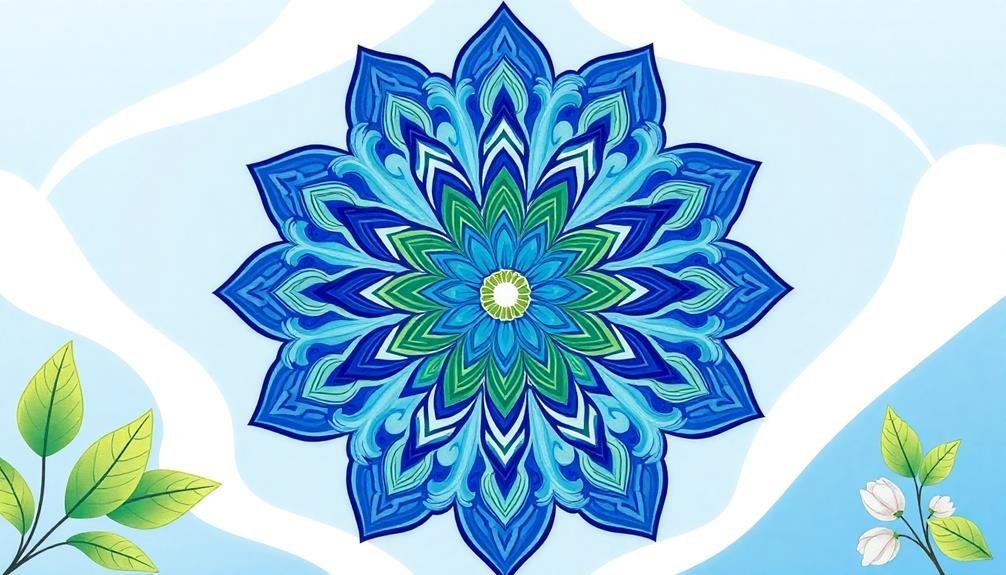
Creating mandala designs can be a powerful way to enhance your mindfulness practice.
You'll discover the benefits of engaging with these intricate patterns, whether you're coloring or crafting your own.
Plus, choosing the right colors can help you cultivate a sense of calm and focus.
Benefits of Mandala Art
Exploring the intricate patterns of mandala art can bring a sense of calm and focus to your mind. This ancient practice has numerous benefits that can help you navigate anxious moments more effectively.
By engaging in mandala art, you're not just creating a beautiful piece; you're also fostering mindfulness and tranquility.
Here are some key benefits of mandala art:
- Enhanced Concentration: The repetitive nature of creating mandalas helps sharpen your focus, drawing your attention away from stressors.
- Stress Relief: The act of coloring or designing mandalas can be meditative, allowing your mind to relax and unwind.
- Emotional Expression: Through colors and shapes, mandalas give you a creative outlet to express feelings that might be hard to articulate.
- Improved Mindfulness: The process encourages you to stay present, helping you cultivate a deeper awareness of your thoughts and emotions.
Incorporating mandala art into your routine can serve as a powerful tool to ease anxiety. As you immerse yourself in this creative process, you'll likely find a greater sense of peace and clarity in your daily life.
Creating Your Own Mandalas
With a blank canvas in front of you, the journey of crafting your own mandalas begins. Embrace the calming experience by gathering your materials—pens, pencils, or markers—and find a quiet space where you can focus. Start by drawing a small dot in the center of your canvas; this will be your mandala's focal point.
From there, let your creativity flow. Use a compass or a round object to create circles around the center, adding layers to your design. As you draw, think about the shapes and patterns that resonate with you. Whether it's flowers, geometric designs, or abstract forms, allow your intuition to guide you.
Remember, there's no right or wrong way to create a mandala. The process itself is meditative and therapeutic. As you work, pay attention to your breath and let go of any distractions. Engaging fully in this artistic practice can help quiet your mind and bring a sense of peace.
When you finish, step back and appreciate your creation. You've not only made art but also engaged in a mindful experience that nurtures your soul.
Using Colors for Calm
In the world of mandala design, colors play an essential role in enhancing your mindfulness practice. Choosing the right colors can help you relax, focus, and process your emotions more effectively.
As you immerse yourself in coloring, consider how different hues can influence your state of mind.
Here are some color associations to keep in mind:
- Blue: Promotes calmness and tranquility.
- Green: Represents balance and harmony with nature.
- Yellow: Invokes feelings of happiness and positivity.
- Purple: Encourages creativity and spiritual growth.
As you fill your mandala with these colors, pay attention to how each shade makes you feel.
Let your intuition guide you; there's no right or wrong way to choose. By engaging with these colors, you'll not only create a beautiful piece of art but also foster a sense of inner peace.
Nature-Inspired Coloring Pages
Nature-inspired coloring pages offer a delightful way to connect with the beauty of the outdoors while releasing your creativity. When you immerse yourself in intricate designs featuring flowers, trees, and wildlife, you can escape the hustle and bustle of daily life.
These pages invite you to focus on the present moment, promoting mindfulness and relaxation. As you color, you'll discover that the act itself can be meditative. Selecting colors for leaves or blossoms allows you to express your unique artistic vision. You might choose vibrant hues to depict a lively spring scene or soft pastels for a tranquil sunset.
Each stroke of your pencil or marker can soothe anxious thoughts and bring a sense of calm. Additionally, nature-inspired themes can spark your imagination. You could create a whimsical garden filled with fantastical creatures or a serene landscape under a starlit sky.
The possibilities are endless, and there's no right or wrong way to bring these pages to life. So, grab your favorite coloring tools, find a cozy spot, and let the wonders of nature inspire your next artistic adventure.
Adult Coloring Book Recommendations
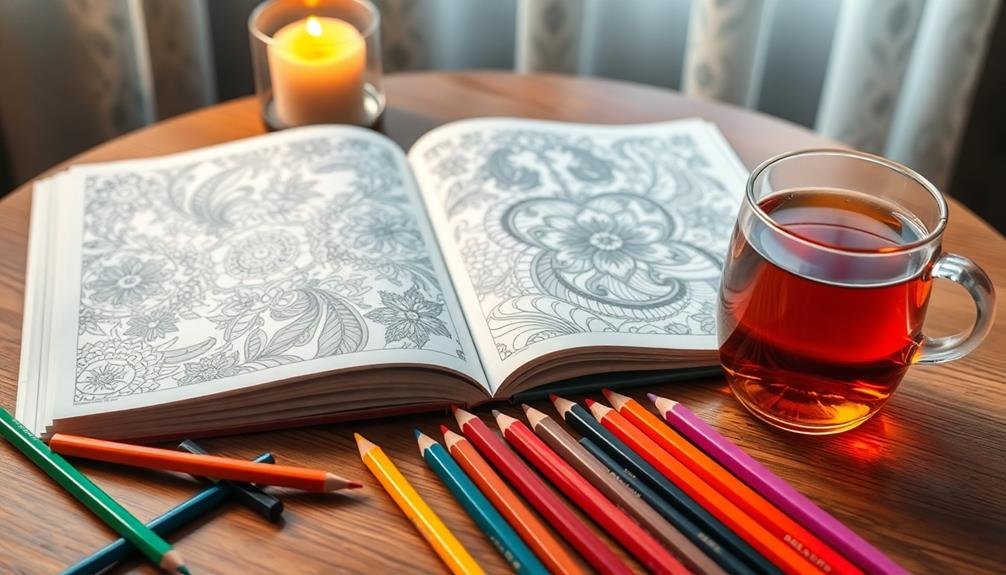
If you're looking to dive deeper into the world of adult coloring, you'll find a plethora of options that cater to various tastes and styles.
These books not only offer a creative outlet but also provide a calming experience. Here are some standout recommendations to get you started:
- "Lost Ocean" by Johanna Basford: This intricate underwater adventure features detailed illustrations of sea life, perfect for those who love marine themes.
- "Color Me Calm" by Lacy Mucklow: Focusing on mindfulness, this book combines beautiful designs with affirmations to enhance relaxation.
- "Enchanted Forest" by Johanna Basford: Step into a whimsical world filled with enchanting creatures and lush landscapes, inviting you to release your imagination.
- "Secret Garden" by Johanna Basford: This classic offers a delightful escape into a hidden garden where you can bring flora and fauna to life with color.
With these coloring books in hand, you'll find joy in every stroke of your colored pencil or marker.
DIY Art Supplies for Relaxation
Creating your own art supplies can be a rewarding way to enhance your relaxation routine. When you craft your materials, you connect more deeply with the art-making process.
Start with DIY paint. Mix equal parts of flour, salt, and water, adding food coloring for vibrant hues. This non-toxic alternative is perfect for painting and easy to clean up.
Next, consider making your own sketchbooks. Bind together sheets of recycled paper using a simple stitch or glue. Personalizing the cover with your favorite colors or patterns adds an extra layer of enjoyment. You'll love having a sketchbook that reflects your style.
For a unique twist, try creating textured stamps from potatoes or sponges. Cut shapes into the surfaces, dip them in your DIY paint, and stamp away. This hands-on approach lets you experiment freely and brings creativity to the forefront.
Lastly, gather natural materials like leaves or flowers to create your own stamps or stencils. Nature provides beautiful designs that can inspire your artwork.
Incorporating Music With Art
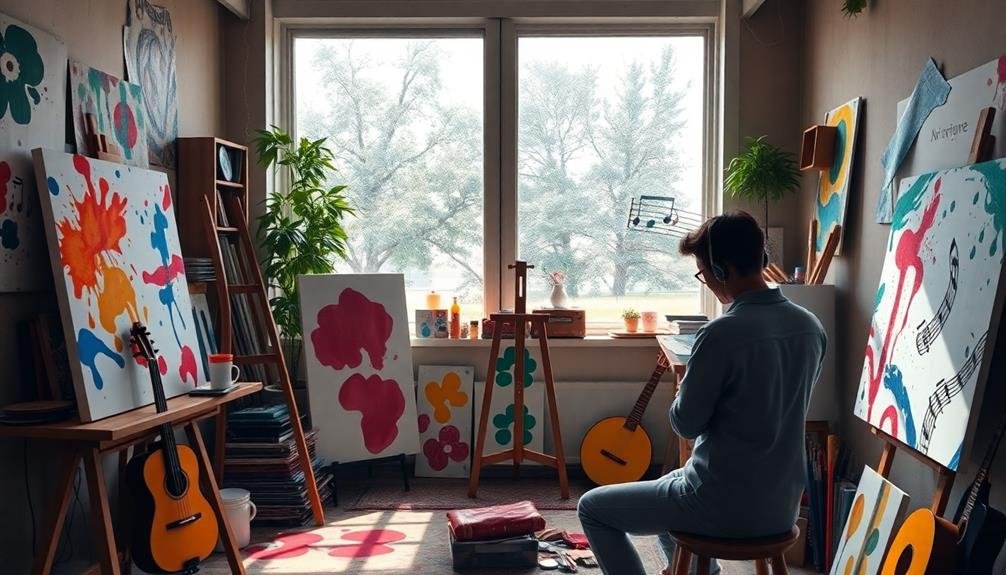
Music can be a powerful source of inspiration for your art projects, sparking creativity in unexpected ways.
You can experiment with rhythmic painting techniques that sync with your favorite tunes, bringing a new energy to your work.
Additionally, creating soundscapes in your workspace can help you focus and enhance your artistic flow.
Music as Creative Inspiration
Art often finds its heartbeat in music, as the two forms of expression intertwine to inspire creativity. When you combine the sounds and rhythms of music with your artistic endeavors, you reveal new dimensions of inspiration.
Here are some ways you can use music as a source of creative fuel:
- Create a Soundtrack: Choose a playlist that resonates with your mood and let it guide your brushstrokes or sculpting techniques.
- Experiment with Genres: Try different music styles—classical, jazz, or even electronic—to see how each genre influences your artistic process.
- Incorporate Lyrics: Use the themes or emotions from your favorite songs to inspire your subject matter, allowing the lyrics to shape your artistic vision.
- Use Music for Rhythm: Let the tempo of a song dictate your pace and flow while working, creating a dynamic connection between your movements and the music.
Rhythmic Painting Techniques
A rhythmic approach to painting can transform your creative process, allowing you to sync your artistic expression with the beats and melodies that move you.
Start by choosing a genre of music that inspires you—whether it's jazz, classical, or upbeat pop. Let the rhythm guide your brush strokes.
Set a timer for a limited period, like 10-15 minutes, and immerse yourself in the music. As the tempo accelerates, allow your movements to become more dynamic. Use larger brushes or even your hands to create bold, sweeping gestures that mimic the music's flow.
You'll find that the energy of the music can help you break free from self-doubt and release your creativity.
You can also experiment with different painting techniques, like splattering or dripping paint, to create a visually rhythmic effect.
Consider layering colors in sync with the music, letting each layer reflect the highs and lows of the sound.
Soundscapes for Focused Creation
Creating an immersive soundscape can enhance your focus and elevate your artistic process. By incorporating music or ambient sounds into your creative routine, you'll find yourself more engaged and less anxious.
Here are some ways to effectively combine sound and art:
- Curate Playlists: Choose music that resonates with your artistic style. Instrumental tracks or nature sounds can foster a calming atmosphere.
- Experiment with Genres: Try different genres to see what inspires you. Classical, jazz, or even electronic music can evoke various emotions that may ignite your creativity.
- Use Sound Apps: Explore soundscape apps that provide a variety of ambient sounds, like rain, ocean waves, or forest sounds, to help you concentrate.
- Set the Mood: Create a ritual where you listen to your chosen soundscape before starting your art. This can signal your brain that it's time to focus and create.
Group Coloring Activities
Coloring together can transform a simple activity into a vibrant social experience, where creativity thrives and connections deepen. When you gather with friends, family, or colleagues for a group coloring session, you create an atmosphere that fosters relaxation and fun. Each person can contribute their unique styles and ideas, leading to a collaborative masterpiece.
Here's how you can set up your group coloring activity:
| Materials Needed | Benefits |
|---|---|
| Coloring books or pages | Encourages creativity |
| Colored pencils or markers | Reduces anxiety |
| Table and chairs | Promotes social interaction |
| Snacks and drinks | Enhances enjoyment |
| Timer (optional) | Adds a playful challenge |
Sharing Your Art Journey
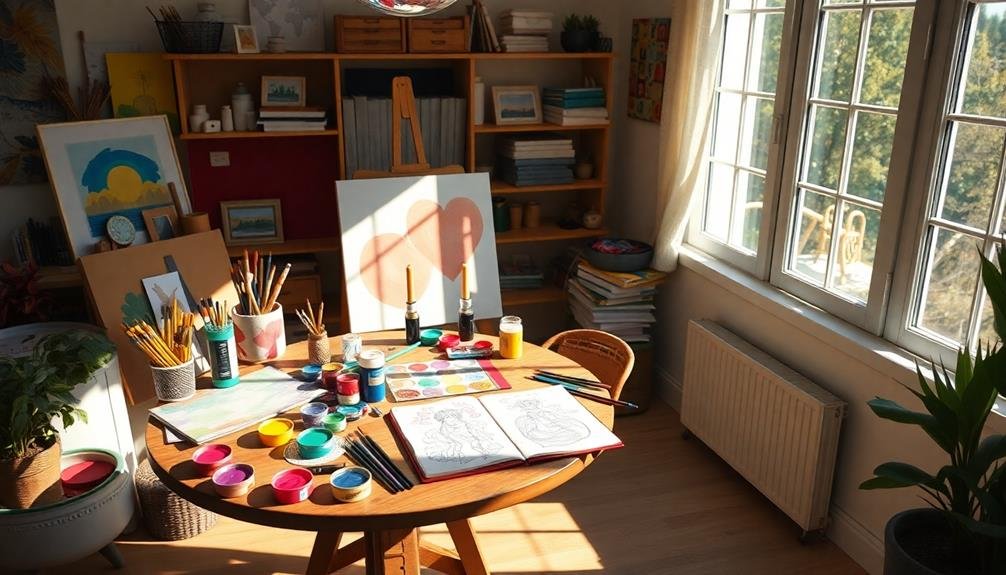
Sharing your art journey can be a rewarding experience that allows you to connect with others while reflecting on your growth as an artist.
When you open up about your creative process, you not only inspire others but also gain valuable feedback. It's a great way to build community and find encouragement.
Here are some ways to share your art journey:
- Social Media: Post your work on platforms like Instagram or Pinterest, using relevant hashtags to reach a larger audience.
- Art Blogs: Start a blog where you document your projects, thoughts, and inspirations. It's a great way to articulate your growth.
- Local Art Shows: Participate in community art exhibitions to showcase your work and meet fellow artists.
- Workshops: Host or attend workshops where you can share techniques and learn from others.
Frequently Asked Questions
Can Children Participate in Adult Coloring Activities for Stress Relief?
Absolutely, you can encourage children to join in on adult coloring activities. It's a great way for them to express creativity and experience relaxation, while also bonding with you over a fun, calming activity.
How Long Should I Spend on a Creative Art Project?
You should spend as long as you feel comfortable on a creative art project. Whether it's thirty minutes or a few hours, focus on enjoying the process rather than worrying about the outcome.
What if I Feel Overwhelmed by My Art Supplies?
If you feel overwhelmed by your art supplies, simplify your setup. Choose a few essentials and focus on one medium at a time. It'll help you feel more in control and spark your creativity.
Are There Specific Colors That Reduce Anxiety?
Certain colors can indeed reduce anxiety. Soft blues and greens promote calmness, while muted pastels create a soothing atmosphere. You can experiment with these shades to see which ones resonate best with your emotions and mindset.
How Can I Find Inspiration for My Art Projects?
To find inspiration for your art projects, explore nature, visit galleries, or immerse yourself in books. Try new mediums, join workshops, and connect with other artists. Sometimes, a simple change in routine sparks creativity!
In Summary
Engaging in creative art projects can truly ease anxious minds and bring a sense of calm. Whether you're coloring intricate mandalas or crafting your own supplies, you're taking a meaningful step towards relaxation. Don't forget to incorporate music for an even richer experience, and consider sharing your journey with others to foster connection. So grab your favorite coloring book or art materials, and let your creativity guide you to a more peaceful state of mind.





Leave a Reply